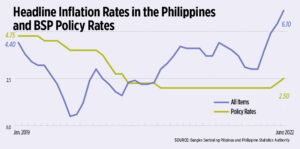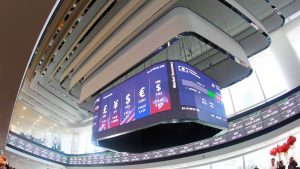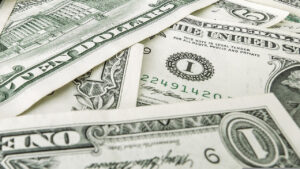Inflation trends, rate hikes to dictate markets for the rest of 2022

By Mariedel Irish U. Catilogo, Researcher
DOMESTIC financial markets may see a lukewarm performance in the remaining months of the year as major central banks around the world grapple to tame inflation.
The barometer Philippine Stock Exchange index (PSEi) finished the April-June period at 6,155.43, down by 14.5% quarter on quarter from the 7,203.47 at the end of first quarter.
The Bangko Sentral ng Pilipinas (BSP) data showed the peso averaged P55.5685 against the greenback in June with P48.1247 last year.
On an end-of-period basis, the local unit finished at P55.0210 versus the dollar in June, weaker than P48.5440 a year ago.
Treasury bill (T-bill) auctions conducted in the second quarter continued to grow as total T-bills reached around P486.3 billion, which was 3.2 times more than the P152-billion aggregate offered amount. This oversubscription amount of P333.8 billion, was lower than the P466.2 billion in the preceding quarter.
Likewise, demands for Treasury bonds (T-bonds) were also strong during the period with a total subscription amount of P717.4 billion, more than twice compared from the offered amount of P304.5 billion.
At the secondary bond market, domestic yields saw an increase of 86.60 basis points (bps) on average in benchmark government securities as of end-June compared with end-March levels, according to the PHP Bloomberg Valuation Service Reference Rates published on the Philippine Dealing System’s website.
The second quarter’s financial market performance saw a favorable activity following the May national election which brought positive business sentiment and economic stability. However, it was not sustained due to the US Federal Reserve’s massive policy rate hikes.
Meanwhile, the consumer price index (CPI) accelerated to a 45-month high of 6.4% year on year in July compared with the 6.1% record in June, data from the Philippine Statistics Authority (PSA) showed.
This brought the average inflation to 4.7%, which surpassed the central bank’s 2-4% target range for the year.
On the other hand, the Philippine economy grew by 7.4% in the second quarter of the year, slower than the 8.2% growth seen in the first three months of the year and the 12.1% in the April-June period a year ago.
This brought the first-half growth at 7.8%, already breaching the revised 6.5-7.5% growth target of the interagency Development Budget Coordination Committee (DBCC).
To tame fast-rising inflation, the central bank has tightened policy rates by a total of 175 bps this year.
INDICATORS TO WATCH OUT FORUnionBank of the Philippines, Inc. Chief Economist Ruben Carlo O. Asuncion said investors and traders should expect a lukewarm market performance year as the US dollar is expected to strengthen in the coming months.
“Nevertheless, the recent mixed signals from the US Fed puts the previous hawkish stance into more uncertainty,” he said.
Mr. Asuncion said the yield on the 10-year US Treasury bond is a good indicator of the US Fed’s hawkish stance, especially now that the US economy has entered a recession.
To recall, the US economy shrank by 0.6% year on year in the second quarter. This came after the 1.6% contraction in the first quarter. The two straight quarterly declines in the gross domestic product meet the standard definition of a technical recession.
“Market players should also keep an eye on rising global inflation as it will cause central banks around the world to raise interest rates. In addition, market players should also pay attention to the increase in gasoline prices brought about by an increase in demand, as well as a weaker USD,” Mr. Asuncion said in an e-mail.
“Inflation trends will likely dictate the direction of central banks and thus bond and foreign exchange markets. Developments in China on the economic front will also drive sentiment,” ING Bank N.V. Manila Senior Economist Nicholas Antonio T. Mapa said in an e-mail interview.
China Banking Corp. Chief Economist Domini S. Velasquez said that market players should look out for consumer and business sentiments and expect the inflation data to accelerate.
“Persistent elevated inflation will lead to further interest rate hikes, but a slowdown in price growth may encourage central banks to opt for a more gradual tightening. Market players should also consider consumer and business sentiments as these will provide insights on the spending plans and inflationary expectations of households and companies in the near-term,” she said in an e-mail.
In a separate e-mail, Rizal Commercial Banking Corp. (RCBC) Chief Economist Michael L. Ricafort said that policy rate hikes by the central bank are likely to be seen as it combats inflationary pressures.
“For the coming months, more local policy rate hikes are still possible, if needed, as a function of any further Fed rate hikes in the quest to bring down elevated US inflation or CPI,” he said.
Likewise, University of Asia and the Pacific (UA&P) Senior Economist Cid L. Terosa said: “Inflation and interest rates will continue to be key factors in the third quarter and the rest of the year.”
“Rate hikes will likely slow growth prospects for the Philippines by curbing nascent investment growth. Slower bank lending caps spending but it also translates to slower job creation as businesses pullback on investment outlays,” ING’s Mr. Mapa said.
UnionBank’s Mr. Asuncion expects the peso to be stronger if the BSP continues to raise interest rates while a good outlook for new bonds in the market are determined.
“The effect of the rising interest rates can be best seen in the fixed-income market. As the central bank increases interest rates, newer bonds will certainly be more profitable, and the prices of existing bonds will decline,” Mr. Asuncion said.
UA&P’s Mr. Terosa sees the negative impact in the equity market following the central bank’s hawkish monetary policy stance.
“Higher interest rates, however, will negatively affect the equities market this quarter because an increase in interest rate will make it more attractive to park funds in bank deposits or fixed-income securities,” he said.
RCBC’s Mr. Ricafort said that rising interest rates in the US would slow down the local economic growth resulting in higher borrowing costs of consumers.
“Higher local policy rates, total of +1.75 since May 2022, could lead to higher borrowing costs or financing costs of households or individuals, businesses, and the government, thereby increasing debt servicing costs especially for the latter that could lead to higher outstanding debt,” he said.
WEAKER PESOAmid the global and domestic monetary policy tightening, the Philippine peso hit the weakest level against the dollar in July. The P56.37 record was the weakest in nearly 17 years or since November 2004.
UA&P’s Mr. Terosa said that those export-oriented industries would likely gain an advantage from a weaker peso.
“The IT-BPM sector, for example, will become more attractive to foreign investors due to a weak peso,” he said.
While an increase in demand side of the country’s export commodities is imminent, China Bank’s Ms. Velasquez said that a weaker global economy will likely offset the momentum.
“Recipients or families of overseas Filipinos will directly feel the benefit of a weaker peso as dollars sent home will be worth more pesos. Exporters and BPO services also stand to benefit,” she said.
UnionBank’s Mr. Asuncion expected growth in the manufacturing and agricultural sector along with recipients of Filipinos working abroad.
“Since exporters are likely to benefit, expect the manufacturing sector to greatly benefit due to electronics being the highest exported product of the country. The agricultural sector is also very likely to benefit as a result of the Philippines’ position as the largest producer of coconut, pineapple, and abaca,” Mr. Asuncion said.
He also noted that the purchasing power of those working abroad remained strong.
FOREIGN EXCHANGE MARKETMs. Velasquez: “We think that the peso would reach its highs in [the third quarter] as seasonality factors showed that businesses will likely ramp up their imports this quarter. The Fed is also set to deliver another interest rate hike in September. The magnitude of this hike relative to the BSP’s policy decisions will either add or ease downward pressure on the peso.”
Mr. Terosa: “The peso will continue to be weak [in the third quarter] because the threat of inflation worldwide is still present. A weak peso will continue to exert upward influence on inflation.”
Mr. Mapa: “Foreign exchange rally and finishing the year at P54.10, but could face bouts of weakness during heavy import season.”
Mr. Ricafort: “The US dollar/peso exchange rate, alongside other major global currencies, positively correlated with the Fed Funds Rate; based on economic cycles (external risk factor beyond the country’s reasonable control that led to stronger US dollar globally in recent weeks/months).”
EQUITIES MARKETMs. Velasquez: “Equities may rally due to positive sentiments on oil prices declining and US inflation possibly slowing down. However, the slowing global economy as well as the rising interest rates and elevated inflation both in the Philippines and the US may still hurt corporate earnings and curb consumer demand.”
Mr. Asuncion: “Equity markets usually perform better as the PSEi traded higher after the BSP’s announcement of a rate hike since it alleviates concerns of the market regarding inflation.”
Mr. Terosa: “This market will be negatively affected by higher interest rates and inflationary pressures. If the peso continues to be weak and inflationary pressures remain, the equities market will experience downward pressure in the third quarter.”
Mr. Ricafort: “President Marcos also signaled no more lockdowns (that were costly for the government and reduced tax collections, widened budget deficits, ballooned the country’s debt since the pandemic started more than two years ago), thereby could help support faster economic growth/recovery, better fiscal/debt management performance than otherwise; thereby leading to higher sales, earnings/income, valuations for some listed companies.
Market sentiment also supported by global crude oil prices still lingering among six-month lows (erased all the increase since the Russia-Ukraine war started on Feb. 24, 2022), thereby could lead to possible easing of trade deficit/net imports, as well as some easing of inflationary pressures and headline inflation in the coming months.”
FIXED-INCOME MARKETMs. Velasquez: “Shorter-tenors will see higher interest rates as the BSP is set to hike rates further in Q3. We may see more demand for new fixed-income securities as interest rates continue to rise.”
Mr. Asuncion: “As the central bank increases interest rates, newer bonds will certainly be more profitable, and the prices of existing bonds will decline.”
Mr. Terosa: “This market will benefit from higher interest rates in [the third quarter].”
Mr. Mapa: “Fixed-income rally as BSP steps up to combat inflation.”
Mr. Ricafort: “There is a chance for a large Retail Treasury Bond (RTB) issuance, given the recent strong appetite for the past month or so, as seen in the weekly T-bond/FXTN auction with bids at more than P100 billion per week for almost all weeks since July 2022. Since local GS yields/PHP BVAL long-end yields are still near the upper part of the cycle, despite the recent easing from pre-pandemic highs posted in the latter part of June 2022, these are attractive for investors to lock in at relatively higher yields, in view of higher inflation.
The large RTB issuance would temper/limit any downside on long-term government securities (GS) yields/PHP BVAL yields for now, given the possible large upcoming RTB offering/supply; as the yields already eased from the new pre-pandemic highs posted in the latter part of June 2022.”




